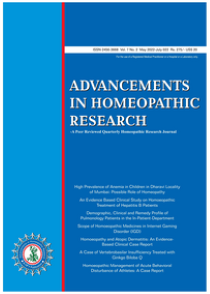Restoring Hair Growth with Individualized Homeopathic Treatment: A Case Report on Alopecia Areata
DOI:
https://doi.org/10.48165/ahr.2025.10.3.4Keywords:
Alopecia areata, Autoimmune, Homoeopathy, Inflammation, case reportAbstract
Alopecia areata, commonly known as spot baldness, is a condition where hair loss occurs in small, circular patches on the scalp or other areas of the body. This autoimmune disorder affects approximately 1-2% of the global population and can develop at any age [1]. Typically, it results in coin-sized bald spots on the scalp, but the condition's course is unpredictable, leading to various forms such as alopecia totalis, alopecia universalis, and ophiasis. Although it is an autoimmune condition, traditional medical treatments often lead to relapses and come with potential side effects. This case involved a 15-year-old female patient who sought treatment at the National Institute of Homoeopathy (N.I.H) outpatient department (OPD) for alopecia areata. The patient underwent individualized homeopathic treatment for seven months, resulting in a complete recovery without any adverse effects. Throughout the treatment process, both the MONARCH score and objective clinical evidence demonstrated significant improvement, confirming the effectiveness of homeopathic treatment. The individualized selection of homeopathic remedies, based on the totality of the patient's symptoms, proved to be a valuable approach in achieving successful outcomes. This case report highlights the potential of homeopathy in managing alopecia areata, particularly in cases where conventional treatments may fail to provide consistent results or cause unwanted side effects. The positive response observed in this patient supports the role of homeopathy as a promising therapeutic option for this challenging condition
References
Villasante Fricke, A. C., & Miteva, M. (2015). Epidemiology and burden of alopecia areata: A systematic review. Clinical, Cosmetic and Investigational Dermatology, 8, 397–403.
Shivanna, C. B., Shenoy, C., & Priya, R. A. (2018). Tofacitinib (selective Janus kinase inhibitor 1 and 3): A promising therapy for the treatment of alopecia areata: A case report of six patients. International Journal of Trichology, 10, 103–107.
Juárez-Rendón, K. J., Rivera Sánchez, G., Reyes López, M. Á., García Ortiz, J. E., Bocanegra García, V., Guardiola Ávila, I., et al. (2017). Alopecia areata: Current situation and perspectives. Archivos Argentinos de Pediatría, 115(e404), 1–11.
Rivetti, E. A. (2005). Alopecia areata: A revision and update. Anais Brasileiros de Dermatologia, 80, 576–588.
Brzezińska-Wcisło, L., Bergler-Czop, B., Wcisło-Dziadecka, D., & Lis-Święty, A. (2014). New aspects of the treatment of alopecia areata. Postępy Dermatologii i Alergologii, 31, 262–265.
Zhang, N.-N., Park, D. K., & Park, H.-J. (2013). Hair growth promoting activity of hot water extract of Thuja orientalis. BMC Complementary and Alternative Medicine, 13(1). Available from: http://dx.doi.org/10.1186/1472-6882-13-9
Park, H. Y., Park, W. S., Park, P. J., Kim, S. N., Kim, A. R., Kang, B. H., et al. (Eds.). (n.d.). Experimental studies of Korean medicinal plant extracts on the effects of hair growth activity and physical properties. Amor Pacific R&D Centre.
Park, W.-S., Lee, C.-H., Lee, B.-G., & Chang, I.-S. (2003). The extract of Thuja occidentalis semen inhibited 5α-reductase and androchronogenetic alopecia of B6CBAF1/j hybrid mouse. Journal of Dermatological Science, 31(2), 91–98. Available from: http://dx.doi.org/10.1016/s0923-1811(02)00146-9
Boericke, W. (1994). Pocket manual of homoeopathic materia medica and repertory. New Delhi: B. Jain Publishers Pvt. Ltd.
Mind Technologies. (2006). Complete repertory of Hompath Classic (Version 8.0). Mumbai: Computer Software.
Lamba, C. D., Gupta, V. K., Van Haselen, R., et al. (2020). Evaluation of the Modified Naranjo Criteria for assessing causal attribution of clinical outcome to homeopathic intervention as presented in case reports. Homeopathy, 109(4), 191–197.
Hahnemann, S. (2013). Organon of medicine (5th & 6th eds., R. E. Dudgeon & W. Boericke, Eds.). New Delhi: B. Jain Publishers Pvt. Ltd.




